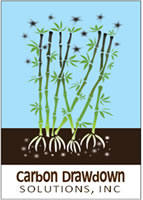The Liquid Carbon Pathway (LCP) is a symbiotic relationship between myccorhizal fungi and 90% of all plants that has developed over the past 420 million years. Plants will purposely produce extra carbohydrates (simple plant sugars) then exude that surplus into the soil to feed the fungi. Myccorhizal fungi cannot live without a host plant and, in exchange for this sugar, the fungi will mine and transport nutrients and water back to its host. For every cubic meter of soil, these fungi will send out as much as 20,000 km (12,000 miles) of hyphae — part of what comprise the fungal mycelium — so that they infiltrate every area of soil. Fungi can access nutrients and water unavailable to the larger plant roots.
Mycorrhizal Fungi — root system of plant
Biochar inoculated with mycchorizal fungi further sequesters carbon in normal agricultural soils long after its application. At CDS, we call this Micro-charged Biochar™ Nurturing this symbiotic relationship with biochar is essential for long-term climate change mitigation and reversal. One of the most notable results of the shift in weather patterns has been a deluge of rain followed by drought. Not only does the biochar itself absorb more water but it also can establish and nurture the growth of myccorhizal fungi (see image at left). Myccorhizal fungi produce glomalin, a sticky substance that cements soil particles together, creating good tilth and passageways for air and water infiltration, allowing soils to absorb and retain more water. Then when drought follows and water become more tightly held by soil particles, it is the fungi that can send its hyphae into the smallest crevices of soil and extract and accumulate molecules of water and transport it back to the thirsty plant.
In a similar way the fungi transport nutrients back to the plant. Fungi can use its acids to release nutrients from soils and even rocks — transforming rock minerals into formats now usable by the plant.
Likewise there are certain nutrients that only bacteria can extract from soils and the fungi will exchange sugar for the nutrient requested by the plant in a complex symbiotic exchange. The study of this relationship has shown that soils under perennial crops that are allowed to fully develop contain more available nutrients than neighboring soils on which agricultural chemicals have been used. A study done at the University of Illinois showed that agricultural chemicals kill or reduce soil microbes resulting in the net loss of soil carbon.
The Liquid Carbon Pathway is the primary means for sequestering long-term soil carbon. It has long been thought that most of the soil carbon was contained in the top 8 inches of the soil strata in the form of the organic matter in humus. It is known that this carbon is liable and easily returned to the atmosphere via bacterial action. Since the discovery of glomalin in 1996 by USDA researcher, Dr. Sara Wright, large amounts of carbon have been found all the way down to 4 feet deep. It is expected, as research goes deeper into soils, that carbon deposits from the LCP will also be scientifically verified.
As the mycorrhizal fungi go deeper into the soil to mine nutrients and water for the plant, they deposit more and more carbon in the form of glomlin — a substance that is believed to be quite stable once it is deposited. The more mature this relationship is between plant and microbe the more volume of soil is accessed on behalf of the plant and the bigger and more reliable is corresponding crop production.
According to research done by Dr. Christine Jones of Australia (view slideshow), pasture soils with healthy LCP associations have been increasing the amount of carbon that they sequester beneath the grasses each year. Currently, some pastures have been sequestering as much as 32 tons of CO2 per hectare/year. This makes biochar even more key to the reversal of climate change because biochar enables this vitally important process. And in areas where all of the mycorrhizal fungi have been killed off, biochar can be inoculated to return them to full productivity.
So in terms of carbon drawdown biochar plays several important functions:
- Sequesters carbon draw down by the plant taking it out of the carbon cycle for centuries
- Increases crop production and thereby the amount of carbon drawn from the air by the increased biomass
- Supports the LCP for centuries so that this plant/microbe symbiosis can remove large amounts of carbon from the air year after year and deposit it in our carbon-starved soils.
More about biochar | About biochar's many applications | How to buy biochar
 Home | About Us | Team | Privacy Policy | Contact Us | © 2011-2013 Carbon Drawdown Solutions, Inc.
| info@cdsbiochar.com | PO Box 1341 Haiku, HI 96708
Home | About Us | Team | Privacy Policy | Contact Us | © 2011-2013 Carbon Drawdown Solutions, Inc.
| info@cdsbiochar.com | PO Box 1341 Haiku, HI 96708